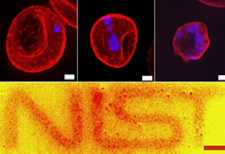A joint research team, working at Commerce’s National Institute of Standards and Technology (NIST) and the National Institute of Allergy and Infectious Diseases (NIAID), has discovered a method of using nanoparticles to illuminate the cellular interior to reveal these slow processes. Nanoparticles, thousands of times smaller than a cell, have a variety of applications. One type of nanoparticle called a quantum dot glows when exposed to light. These semiconductor particles can be coated with organic materials, which are tailored to be attracted to specific proteins within the part of a cell a scientist wishes to examine. (More)
- Home
- The Commerce Blog
- Newsroom
- Economic Indicators
- Office of the Secretary
- Office of Business Liaison
- Center for Faith Based and Neighborhood Partnerships
- Native American Affairs
- Office of the Chief Financial Officer and Assistant Secretary for Administration
- Office of the Chief Information Officer
- Office of the Executive Secretariat
- Office of General Counsel
- Office of Inspector General
- Office of Legislative and Intergovernmental Affairs
- Office of Policy and Strategic Planning
- Office of Public Affairs
- About Commerce
- Contact Us



Comments Closed
Due to increased spam, comments have been closed on this content. If you wish to comment about the content, we encourage you to email webmaster@doc.gov.